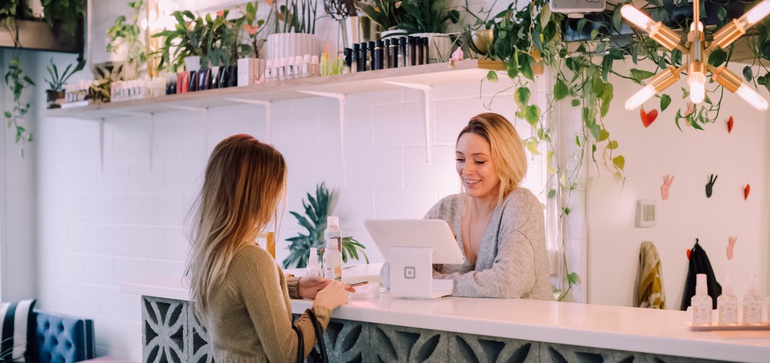Independent retailers are going through an accelerated change, with increased payment options, a public that wants to shop local and attention from Amazon.
America depends on small businesses. More than 50% of people in this country either own or work for a small business, and those companies create about two out of every three new jobs annually, according to the U.S. Small Business Administration. Retail is responsible for a little over 35% of small business employment.
May 5-11 marks National Small Business Week, which recognizes the contributions of entrepreneurs. Overarching patterns illustrate what is happening to this segment of the retail industry and show that large chains are beginning to take the lessons of independent companies and apply them at scale. The most impactful of those decisions may be bringing down the square footage of brick and mortar locations. At the same time, independent retailers are starting to experiment with solutions that used to only be available to mass marketers or large national chains. For example, as technology improves and becomes more affordable, small businesses are able to deploy savvy payment solutions. And retail locations of all sizes are beginning to delve into what mixed use can look like, especially when it comes to building out coworking spaces.
This playful interaction back and forth between what is happening at both small and large corporations is pushing retail to evolve. Here are some top trends that impacted retail small businesses this past year.
1. Small Business Saturday cashes in
Nov. 24 marked the ninth annual Small Business Saturday, which brought in a record $17.8 billion in sales. Over the years the event has gained traction, and now boasts participants in all 50 states, Washington, D.C. and Puerto Rico. Seventy percent of American adults reported awareness of the event, 42% actively participated by making a purchase in-store and 41% purchased local online. But, while sales were the highest ever, an estimated 104 million U.S. consumers reported shopping at independently owned companies — down from 108 million the year prior.
The 2018 Small Business Owner Insights Survey by American Express and the National Federation of Independent Business revealed that 59% of Small Business Saturday companies said that the retail event contributes significantly to their annual holiday sales.
2. Small format stores are all the rage
Large retailers have taken note of mom and pop shops and experimented with a reduced store size. In April, Ikea opened a “Planning Studio” in New York City. The space occupies a little over 17,000 feet, which is much smaller than its showroom/warehouse counterparts, and acts as a showroom where consultants work with shoppers in a service-driven environment.
Target is on track to have 130 small-format stores by the end of this year, Nordstrom is experimenting with its Nordstrom Local concept (and recently opened two new locations) and Kohl’s is on the small-footprint bandwagon to reduce costs. At the end of last year, Amazon opened a Go store that was approximately 450 square feet. The company explained that a smaller design would be aimed at office lobbies and other public spaces like hospitals.
3. Payment options increase
According to a study from Juniper Research almost 2.1 billion global consumers are expected to use mobile wallets for payments or money transfer in 2019 — a 30% growth year over year. While frictionless payments have been a major talking point for big-box retailers for some time, smaller businesses are incorporating different payment tools into transactions including Square, PayPal and Apple Pay.
In March, Square announced its Invoices app, which allows sellers to manage and send invoices from their smartphones. “Small business owners are able to get paid remotely and access their funds quickly and securely,” said Square Seller Lead Alyssa Henry, in a statement regarding the technology. The company also revamped its Square Online Store and Square for Retail to streamline e-commerce sales operations, specifically to aid small businesses. And this past fall the payments company introduced Square Installments so merchants can establish installment payment programs for both online and in-store purchases.
At the end of April, Shopify launched a new technology series, the “Shopify Tap & Chip Reader, Dock, and Retail Stand.” The suite groups contactless payments, inventory management functions and hardware, secure payments and front end hardware, including a tablet and dock.
4. Amazon strategically positions its marketplace
Small and medium size businesses (SMBs) are an important driver for the e-commerce giant. In 2018, third-party merchandise sales, which are primarily generated by SMBs, surpassed $160 billion and made up more than 50% of units sold in Amazon stores, according to a company press release. Third-party sales “are growing at a faster rate than first-party sales on Amazon and across retailers in the U.S.” the company stated.
Amazon merged marketplace and retail operations in June last year. The focus on independent businesses relieves the company from fulfillment and delivery because Marketplace sellers can store, fulfill and deliver goods they sell through Amazon or pay the company to help with supply chain logistics.
5. Small business partners with coworking
In an effort to reimagine a store’s footprint, a number of retailers are experimenting with adding coworking spaces. In 2016, Staples partnered with office-sharing company Workbar, and even though that partnership has ended, the retailer announced in February that its own coworking concept is currently in development.
The multiuse concept is growing in popularity and is expanding its reach into the indie market. Startup Re:store in San Francisco brings together various brands and doubles as a coworking space for retailers. In Washington, D.C., independent beauty store Take Care recently added a wellness-oriented office space inside its store. And even coworking juggernaut WeWork is highlighting small businesses through its WeMRKT retail concept, which sells items made by its members, including snacks, office supplies and apparel.
Follow Kaarin Vembar on Twitter

